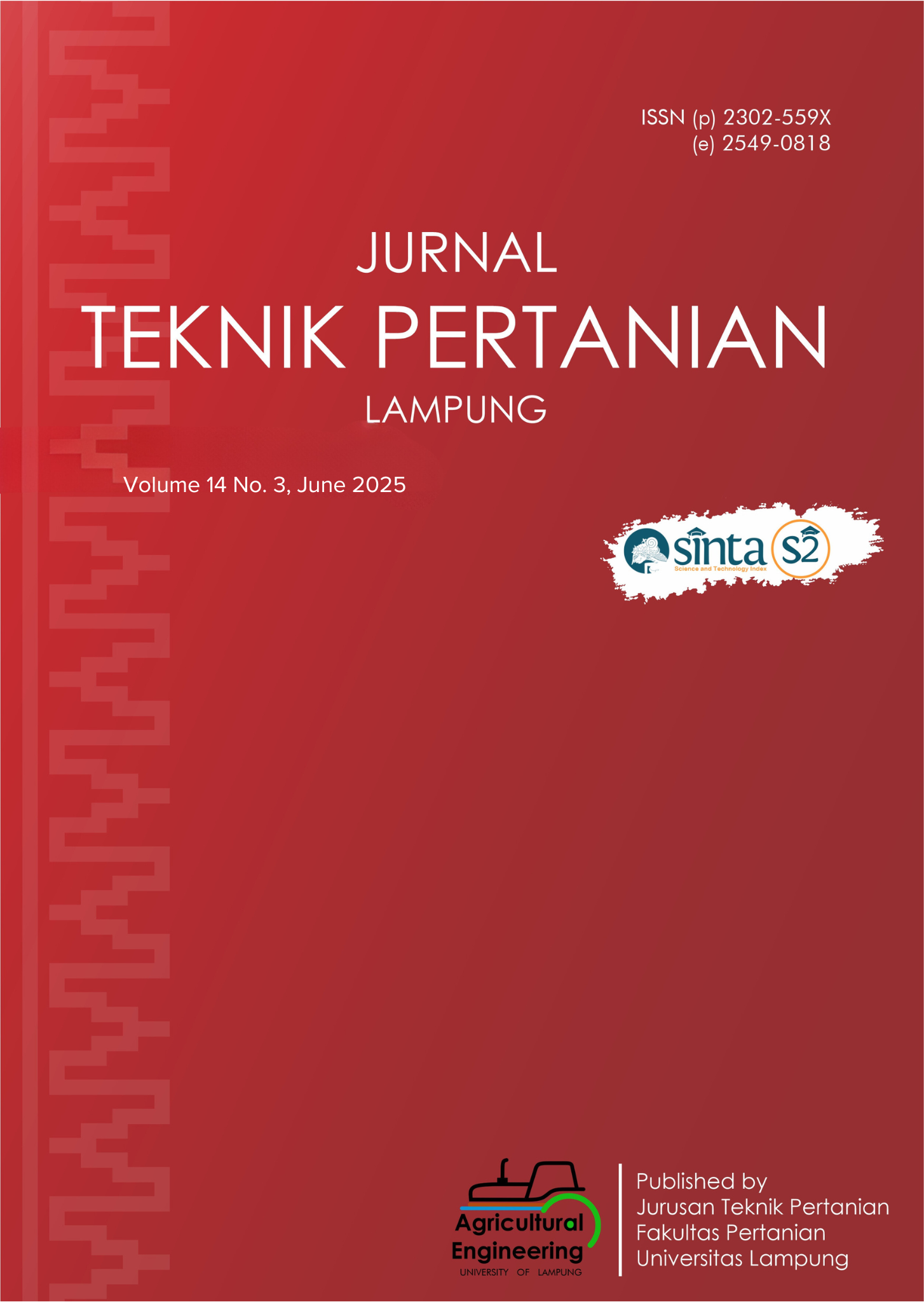Enhancing Sustainability in Packaging: Response Surface Optimized Sago Pith Waste Biocomposites with PBAT and MDI
DOI:
https://doi.org/10.23960/jtep-l.v14i3.979-990 Abstract View: 92
Abstract View: 92
Abstract
This study aims to optimize the biocomposites of sago pith waste (SPW) for sustainable packaging applications. The biocomposite was prepared using the biodegradable polymer polybutylene adipate-co-terephthalate (PBAT) as a matrix and methylendifenyl diisocyanate (MDI) as a chain extender. RSM-CCD was used to assess the impact of the incorporation of SPW (5-20% p/p) and MDI (1–5%) into the PBAT matrix on the tensile strength and elongation of biocomposites by melt mixing. The optimal formula shown by RSM was 5% SPW and 5% MDI, which resulted in a 5.14 MPa tensile strength and 8.14% elongation. The barrier properties of all treatments, including moisture content, contact angle, and water absorption, were checked. The optimal formula showed good barrier properties compared to other treatments: water content of 3.12%, contact angle of 42.84°, and water absorption of 0.82%. Other characterizations of SEM, FTIR, DSC, TGA, and biodegradability tests showed an increase in SPW-PBAT compatibility due to the use of MDI. MDI as a chain extender had a positive impact on the material's strength, and the addition of SPW accelerated the degradation process, thus improving biodegradability.
Keywords: Biocomposite, Chain extender, Melt-mixing, Response Surface Methodology, Sago pith waste.
Downloads
References
Albooyeh, A., Soleymani, P., & Taghipoor, H. (2022). Evaluation of the mechanical properties of hydroxyapatite-silica aerogel/epoxy nanocomposites: Optimizing by response surface approach. Journal of the Mechanical Behavior of Biomedical Materials, 136, 105513. https://doi.org/10.1016/j.jmbbm.2022.105513
Almond, J., Sugumaar, P., Wenzel, M.N., Hill, G., & Wallis, C. (2020). Determination of the carbonyl index of polyethylene and polypropylene using the specified area under band methodology with ATR-FTIR spectroscopy. E-Polymers, 20(1), 369–381. https://doi.org/10.1515/epoly-2020-0041
ALP (Associated Labels & Packaging). (2020). What Do Barrier Properties Do? https://associatedlp.com/news/2020/what-do-barrier-properties-do (Accessed at 23 May 2025)
Azura, A.R., Adzami, N.S., & Tajarudin, H.A. (2017). Utilization of Metroxylan sagu pith waste as biodegradable filler for natural rubber (NR) latex films. Solid State Phenomena, 264, 198–201. https://doi.org/10.4028/www.scientific.net/SSP.264.198
Barczewski, M., Mysiukiewicz, O., & Kloziński, A. (2018). Complex modification effect of linseed cake as an agricultural waste filler used in high density polyethylene composites. Iranian Polymer Journal, 27, 677–688. https://doi.org/10.1007/s13726-018-0644-3
Belaadi, A., Laouici, H., & Bourchak, M. (2020). Mechanical and drilling performance of short jute fibre-reinforced polymer biocomposites: Statistical approach. International Journal of Advanced Manufacturing Technology, 106, 1989–2006. https://doi.org/10.1007/s00170-019-04761-4
Benzannache, N., Belaadi, A., Boumaaza, M., & Bourchak, M. (2021). Improving the mechanical performance of biocomposite plaster/ Washingtonian filifira fibres using the RSM method. Journal of Building Engineering, 33, 101840. https://doi.org/10.1016/j.jobe.2020.101840
Bishop, G., Styles, D., & Lens, P.N.L. (2020). Recycling of European plastic is a pathway for plastic debris in the ocean. Environment International, 142, 105893. https://doi.org/10.1016/j.envint.2020.105893
Cai, X., Yang, X., Zhang, H., & Wang, G. (2018). Aliphatic-aromatic poly(carbonate-co-ester)s containing biobased furan monomer: Synthesis and thermo-mechanical properties. Polymer, 134, 63–70. https://doi.org/10.1016/j.polymer.2017.11.058
Fabian, D.R.C., Durpekova, S., Dusankova, M., Cisar, J., Drohsler, P., Elich, O., Borkova, M., Cechmankova, J., & Sedlarik, V. (2023). Renewable poly(lactic acid)lignocellulose biocomposites for the enhancement of the water retention capacity of the soil. Polymers, 15(10), 2243. https://doi.org/10.3390/polym15102243
Dixit, S., & Yadav, V.L. (2019). Optimization of polyethylene/polypropylene/alkali modified wheat straw composites for packaging application using RSM. Journal of Cleaner Production, 240, 118228. https://doi.org/10.1016/j.jclepro.2019.118228
Fauziah, A.R., Lanuru, M., Syahrul, M., & Werorilangi, S. (2020). Utilization of solid waste from sago flour industry (sago pith waste) as biodegradable plastic. Advances in Environmental Biology, 14(1), 42–47. https://doi.org/10.22587/aeb.2020.14.1.7
Gapsari, F., Purnowidodo, A., Hidayatullah, S., & Suteja, S. (2021). Characterization of Timoho fiber as a reinforcement in green composite. Journal of Materials Research and Technology, 13, 1305–1315. https://doi.org/10.1016/j.jmrt.2021.05.049
Giri, J., Lach, R., Grellmann, W., Susan, M.A.B.H., Saiter, J.M., Henning, S., Katiyar, V., & Adhikari, R. (2019). Compostable composites of wheat stalk micro- and nanocrystalline cellulose and poly(butylene adipate-co-terephthalate): Surface properties and degradation behavior. Journal of Applied Polymer Science, 136(43), 1–11. https://doi.org/10.1002/app.48149
Guimarães, M.R., Scatolino, M.V., Martins, M.A., Ferreira, S.R., Mendes, L.M., Lima, J.T., Junior, M.G., & Tonoli, G.H.D. (2022). Bio-based films/nanopapers from lignocellulosic wastes for production of added-value micro-/nanomaterials. Environmental Science and Pollution Research, 29(6), 8665–8683. https://doi.org/10.1007/s11356-021-16203-4
Hejna, A., Barczewski, M., Kosmela, P., Mysiukiewicz, O., Tercjak, A., Piasecki, A., Saeb, M.R., & Szostak, M. (2023). Sustainable chemically modified mater-bi/poly(ε-caprolactone)/cellulose biocomposites: Looking at the bulk through the surface. Research Square. https://doi.org/10.21203/rs.3.rs-3064683/v1
Hejna, A., Sulyman, M., Przybysz, M., Saeb, M.R., Klein, M., & Formela, K. (2020). On the correlation of lignocellulosic filler composition with the performance properties of poly(ε-caprolactone) based biocomposites. Waste and Biomass Valorization, 11(4), 1467–1479. https://doi.org/10.1007/s12649-018-0485-5
Istikowati, W.T., Sutiya, B., Sunardi, S., & Sunardi, S. (2021). Utilization of sago waste as animal feed material in Pemakuan Laut Village, Sungai Tabuk, Banjar Regency, South Kalimantan. PengabdianMu: Jurnal Ilmiah Pengabdian Kepada Masyarakat, 6(2), 149–155. https://doi.org/10.33084/pengabdianmu.v6i2.1822
Khazabi, M., & Sain, M. (2014). Morphological and physico-thermal properties of soy-based open-cell spray polyurethane foam insulation modified with wood pulp fiber. Advances in Petroleum Exploration and Development, 7(1), 1–6.
Lai, J.C., Rahman, W.A.W.A., & Toh, W.Y. (2014). Mechanical, thermal and water absorption properties of plasticised sago pith waste. Fibers and Polymers, 15(5), 971–978. https://doi.org/10.1007/s12221-014-0971-8
Li, C., Chen, F., Lin, B., Zhang, C., & Liu, C. (2021). High content corn starch/Poly (butylene adipate-co-terephthalate) composites with high-performance by physical–chemical dual compatibilization. European Polymer Journal, 159, 110737. https://doi.org/10.1016/j.eurpolymj.2021.110737
Liu, Y., Liu, S., Liu, Z., Lei, Y., Jiang, S., Zhang, K., Yan, W., Qin, J., He, M., Qin, S., & Yu, J. (2021). Enhanced mechanical and biodegradable properties of PBAT/lignin composites via silane grafting and reactive extrusion. Composites Part B: Engineering, 220, 108980. https://doi.org/10.1016/j.compositesb.2021.108980
Mahata, D., Cherian, A., Parab, A., & Gupta, V. (2020). In situ functionalization of poly(butylene adipate-co-terephthalate) polyester with a multi-functional macromolecular additive. Iranian Polymer Journal, 29, 1045–1055. https://doi.org/10.1007/s13726-020-00860-2
Moustafa, H., Guizani, C., Dupont, C., Martin, V., Jeguirim, M., & Dufresne, A. (2017). Utilization of torrefied coffee grounds as reinforcing agent to produce high-quality biodegradable PBAT composites for food packaging applications. ACS Sustainable Chemistry and Engineering, 5(2), 1906–1916. https://doi.org/10.1021/acssuschemeng.6b02633
Nissa, R.C., Fikriyyah, A.K., Abdullah, A.H.D., & Pudjiraharti, S. (2019). Preliminary study of biodegradability of starch-based bioplastics using ASTM G21-70, dip-hanging, and soil burial test methods. IOP Conference Series: Earth and Environmental Science, 277, 012007. https://doi.org/10.1088/1755-1315/277/1/012007
Pan, H., Li, Z., Yang, J., Li, X., Ai, X., Hao, Y., Zhang, H., & Dong, L. (2018). The effect of MDI on the structure and mechanical properties of poly(lactic acid) and poly(butylene adipate-co-butylene terephthalate) blends. RSC Advances, 8, 4610–4623. https://doi.org/10.1039/c7ra10745e
Plastics Europe. (2021). Plastics the fact 2021. Plastics Europe market research group (PEMRG) and conversio market & strategy GmbH, 1–34. https://plasticseurope.org/
Rajeshkumar, G., Seshadri, S.A., Devnani, G.L., Sanjay, M.R., Siengchin, S., Maran, P.J., Al-Dhabi, N.A., Karuppiah, P., Mariadhas, V.A., Sivarajasekar, N., & Anuf, A.R. (2021). Environment friendly, renewable and sustainable poly lactic acid (PLA) based natural fiber reinforced composites – A comprehensive review. Journal of Cleaner Production, 310, 127483. https://doi.org/10.1016/j.jclepro.2021.127483
Rashid, M.b.M.R., Mijarsh, M.J.A., Seli, H., Johari, M.A.M., & Ahmad, Z.A. (2018). Sago pith waste ash as a potential raw material for ceramic and geopolymer fabrication. Journal of Material Cycles and Waste Management, 20, 1090–1098. https://doi.org/10.1007/s10163-017-0672-7
Rasyida, A., Fukushima, K., & Yang, M-C. (2017). Structure and properties of organically modified poly(butylene adipate-co-terephthalate) based nanocomposites. IOP Conference Series: Materials Science and Engineering, 223, 012023. https://doi.org/10.1088/1757-899X/223/1/012023
Scaffaro, R., Maio, A., Sutera, F., Gulino, E.F., & Morreale, M. (2019). Degradation and recycling of films based on biodegradable polymers: A short review. Polymers, 11(4), 651. https://doi.org/10.3390/polym11040651
Seo, Y-R., Bae, S-U., Gwon, J., Wu, Q., & Kim, B-J. (2020). Effects of methylenediphenyl 4,4’-diisocyanate and maleic anhydride as coupling agents on the properties of polylactic acid/polybutylene succinate/wood flour biocomposites by reactive extrusion. Materials, 13(7), 1660. https://doi.org/10.3390/ma13071660
Siruru, H., Syafii, W., Wistara, I.N.J., & Pari, G. (2019). Characteristics of metroxylon rumphii (pith and bark waste) from Seram Island, Maluku, Indonesia. Biodiversitas, 20(12), 3517–3526. https://doi.org/10.13057/biodiv/d201208
Song, M-M., Branford-White, C., Nie, H-L., & Zhu, L-M. (2011). Optimization of adsorption conditions of BSA on thermosensitive magnetic composite particles using response surface methodology. Colloids and Surfaces B: Biointerfaces, 84(2), 477–483. https://doi.org/10.1016/j.colsurfb.2011.02.002
Venkatachalam, H., & Palaniswamy, R. (2020). Bioplastic world: A review. Journal of Advanced Scientific Research, 11(3), 43–53. https://sciensage.info/index.php/JASR/article/view/505
Xie, X., Zhang, C., Weng, Y., Diao, X., & Song, X. (2020). Effect of diisocyanates as compatibilizer on the properties of BF/PBAT composites by in situ reactive compatibilization, crosslinking and chain extension. Materials, 13(3), 806. https://doi.org/10.3390/ma13030806
Xu, J., Feng, K., Li, Y., Xie, J., Wang, Y., Zhang, Z., & Hu, Q. (2024). Enhanced biodegradation rate of poly(butylene adipate-co-terephthalate) composites using reed fiber. Polymers, 16(3), 411. https://doi.org/10.3390/polym16030411
Yee, T.W., Sin, L.T., Rahman, W.A.W.A., & Samad, A.A. (2011). Properties and interactions of poly(vinyl alcohol)-sago pith waste biocomposites. Journal of Composite Materials, 45(21), 2199–2209. https://doi.org/10.1177/0021998311401073
Downloads
Published
How to Cite
Issue
Section
License
Authors who publish with this journal agree to the following terms:
Authors retain copyright and grant the journal right of first publication with the work simultaneously licensed under a Creative Commons Attribution-ShareAlike 4.0 International Lice that allows others to share the work with an acknowledgement of the work's authorship and initial publication in this journal.
Authors are able to enter into separate, additional contractual arrangements for the non-exclusive distribution of the journal's published version of the work (e.g., post it to an institutional repository or publish it in a book), with an acknowledgement of its initial publication in this journal.
Authors are permitted and encouraged to post their work online (e.g., in institutional repositories or on their website) prior to and during the submission process, as it can lead to productive exchanges, as well as earlier and greater citation of published work (See The Effect of Open Access).
Jurnal Teknik Pertanian Lampung

JTEPL is licensed under a Creative Commons Attribution-ShareAlike 4.0 International License.













